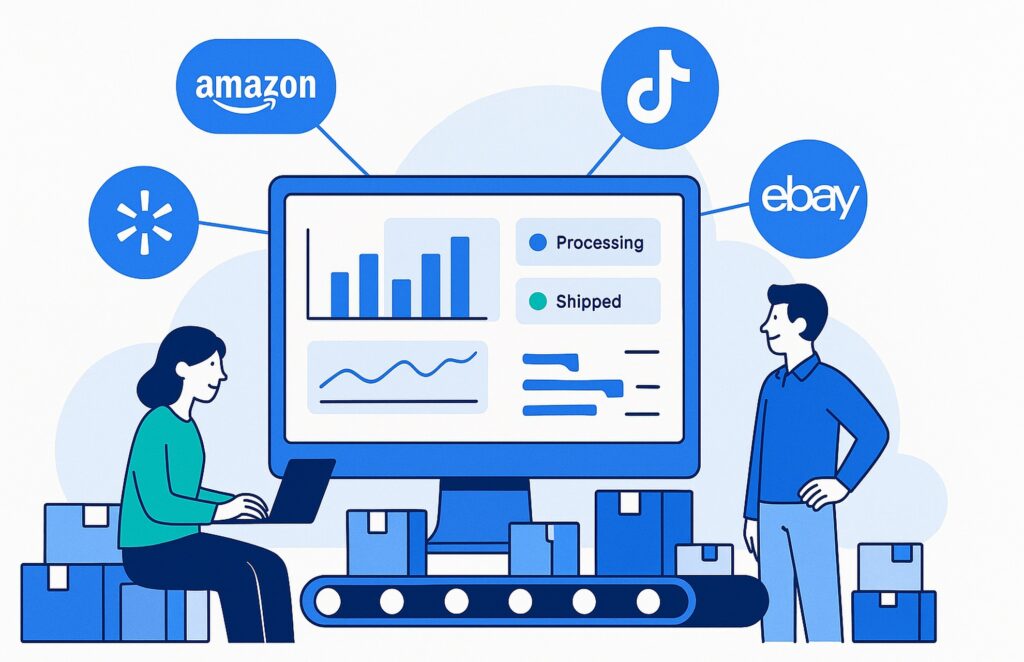- Blog
-
For Sellers
Top 5 software for high-converting product listings on Amazon
You don’t need more hours in the day. You need smarter tools to make your Amazon listings work harder.

Amazon listings that convert aren’t accidents. They’re the result of smart optimization and the right tools backing your strategy. Sure, you could spend hours writing the perfect product title or manually researching keywords, but that approach doesn’t scale when you’re serious about building a profitable Amazon business.
The most successful sellers use specialized listing software to automate optimization, uncover high-performing keywords, and create content that actually converts browsers into buyers. These tools do the heavy lifting so you can focus on what matters: growing your revenue.
From Amazon’s built-in A+ Content Manager to powerful third-party solutions, the right listing software can transform your product pages from overlooked listings into sales magnets. Here’s what you need to know about the top options available and how they can boost your conversion rates.
Amazon product page management: A+ Content
A+ Content Manager is one of the tools Amazon offers to help sellers improve their rankings and sales. It also belongs to the New Seller Guide service suite, which aids new storefront owners in their critical first 90 days.
A+ Content can be accessed for free by sellers registered in the Amazon Brand Registry—except those with offers in the book, music, and DVD categories. Professional selling plan subscriptions come with this feature as well.
The content manager lets you customize your product pages with brand elements, layout options, and extra images, including comparison charts and lifestyle photos. To help you stand out, the tool also provides a Brand Story section where you can share your business history and mission, share a link to your storefront, or cross-sell products.
Amazon also makes it easy to experiment and discover the most effective way to connect with your shoppers through the A/B testing feature, where you can run two versions of your listing created through A+. However, split testing is only available to brand owners in the US, Mexico, Canada, the EU5 (France, Germany, Italy, Spain, and the United Kingdom), India, and Japan at the moment.
Lastly, A+ Content offers data on sold units and conversions to help you design future listings based on previously high-converting items.
Top 5 Amazon product listing software
Innovative as it is, the A+ Content Manager only focuses on highlighting visuals and testing your product page. You can make your listings even more impactful with the help of the following software:
1. ZonGuru
ZonGuru boasts its ChatGPT 4-enabled Listing Optimizer. The platform claims that the tool can boost its users’ optimization scores 37% higher than their category leaders on its dedicated page. The AI can rewrite product listings or auto-generate them, featuring the ideal keywords identified by its flagship Keywords on Fire search tool. The optimizer also has a listing strength scoring system, which lets you see how your listing fares against up to 8 other ASINs.
Meanwhile, its AI “Power” features allow you to customize your content based on your brand’s personality and preferred language. You can also use it for negative keyword matching and copying entire lists. ZonGuru offers to send a “superior” version of your current ASIN for free when you fill out their form for an Amazon listing analysis.
2. Viral Launch
Viral Launch offers an A+ Content Generator, powered by its LaunchGPT AI. It creates Amazon-compliant text for A+ modules, including descriptions, alt text, and comparison charts.
The platform’s SEO tools also include Keyword Research for finding high-relevance, low-competition terms, and Keyword Manager for tracking up to 2,000 terms and suggesting keywords for ad campaigns. Its Listing Builder helps refine your listings with an optimization score and keyword analysis. Meanwhile, the Split Testing feature allows you to compare up to seven versions of keywords or images to maximize results.
3. MerchantWords
MerchantWords (MW) helps sellers boost their Amazon listings’ SEO with tools like Digital Shelf, which tracks your search share, ASIN rankings, and top keywords. Its ASIN Plus feature uncovers high-performing keywords used by competitors, while Page 1 Products reveals which listings rank on Amazon’s search results for a given term.
MW also offers keyword discovery tools, such as Classic Search and Emerging Trends. These two identify terms that shoppers are actively searching for. For those looking to optimize listings quickly, MW’s AI-powered Listing Writer can draft a product page in minutes, or you can opt for a custom listing service for more tailored results.
4. Helium 10
Helium 10 offers Amazon sellers an AI-powered Listing Builder that suggests keywords by pulling insights from competitors’ top-performing ASINs. They also have a Scribbles feature that helps sellers organize and track high-demand keywords, making it easier to optimize listings.
For refining existing product pages, the Listing Analyzer evaluates your copy against Helium 10’s optimization checklist and compares it with competitors. Additionally, the Frankenstein keyword list processor cleans up large keyword lists by removing duplicates and sorting them by popularity.
5. Jungle Scout
Jungle Scout’s Keyword Scout pinpoints high-converting terms and top-ranking keywords, including those used by competitors. The AI-driven Listing Builder then helps you apply these terms from your Keyword Bank directly to your product page.
Jungle Scout also has a Listing Optimization Score that provides real-time feedback on your title, description, and features. Plus, their Rank Tracker monitors your keyword performance and compares it with competitors over time.
SEO tips to satisfy Amazon’s A10 algorithm
Having great Amazon listing software is helpful. But to truly get ahead, you need to master SEO strategies that align with Amazon’s A10 algorithm. Here’s how to make sure your listings get the visibility they deserve.
As discussed in our Amazon A10 Algorithm guide, the world’s top online retailer considers several factors when ranking products. This “A10” system allows the platform to determine the most relevant products to display based on a shopper’s search intent. These ranking factors include:
- The written product description (particularly keywords included)
- Seller authority (conversion rate, sales, and reviews)
Listing optimization through SEO also tops Amazon’s list of recommended ways to boost a listing‘s performance. Its other suggestions include placing ads, using Amazon Attribution, and collecting Amazon Vine reviews. As Amazon puts it, product listing optimization means refining a product page’s details to highlight its features and benefits, ultimately driving higher sales.
Although AI tools can generate entire listings, best practice dictates that you edit their output to align with your brand tone and business goals. Take the following steps:
1. Research top-performing keywords.
All the listing software programs featured above have keyword research tools. Why? Because you need them to identify the words and phrases your customers use when searching for products like yours. Include both short and long-tail keywords.
Short-tails are hard to rank for but enjoy high visibility due to their broad coverage (for example: “keyboard” or “French press”). Long-tail phrases are best for new sellers as they typically have lower search volumes—therefore less competition, improving conversion rate due to their specific search intent (for instance: “mechanical mini wireless keyboard for Mac,” or “3-cup stainless steel French press.”)
2. Write concise and compelling titles.
Amazon recommends keeping title lengths to 80 characters or fewer, although the limit is 200 characters. Highlight the brand name, product type, and description, like size or color. Also, ensure that your primary keyword is part of your product title.
Titles of top-selling products typically have these traits:
- A higher share of positive sentiment words
- Average readability and leaning toward SEO
- Highly connected keywords usually appear among the first eight words of a product title
3. Make your product descriptions informative.
Use your secondary keywords or keyword variations when describing the details about your product, but avoid keyword stuffing, as this can bring down your ranking. Your description should mention what material your item is made of, its sizing, color, dimensions, and quantity. You should also add care instructions, warranty information, and model numbers with compatibility information for tech-related products.
4. Use bullet points.
Make it easy for shoppers to process information by dividing your product details into bulleted lines. Amazon suggests using fewer than 1,000 characters and five bullet points at most for describing items.
The best descriptions start with a feature followed by its benefit. For instance, one of the bullet points for a hair dryer and volumizer brush might read: “3 heat/speed settings and cool option for styling flexibility.”
Amazon’s other tips include using sentence fragments for bullet points and starting them with a capital letter. Moreover, numbers should appear as numerals and spell out measurements. Exclude promotional and shipping information.
5. Include back-end search terms.
Invisible to customers, back-end keywords are synonyms and alternative names of your products (no articles and prepositions) that you can add to your product catalog. To do this, head toward “Manage All Inventory” in your Seller Central account and click “Edit.” Once you see the “Product Details” tab appear, type keywords in the “Generic keyword” field.
Go beyond listing optimization with Threecolts
While listing optimization gets your products discovered, it’s just one piece of the Amazon success puzzle. The most profitable sellers understand they need a complete toolkit—from sourcing winning products to managing inventory, tracking profits, and staying competitive.
That’s where Seller 365 comes in. For just $69 per month, you get access to 10 Amazon selling apps, including ScoutX for instant product research directly on Amazon pages, InventoryLab for seamless FBA prep and shipping, and SmartRepricer for automated competitive pricing.
Instead of paying separately for listing optimization software, then adding more tools for sourcing, inventory management, and repricing—easily reaching $300+ monthly—Seller 365 gives you everything in one place.
Ready to stop juggling multiple subscriptions and start focusing on what really matters—growing your revenue? Try Seller 365 free for up to 14 days and see how an integrated approach transforms your Amazon business.






















